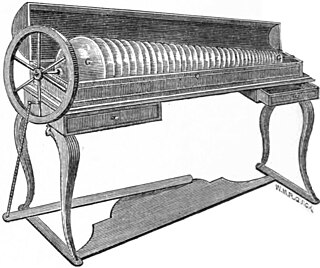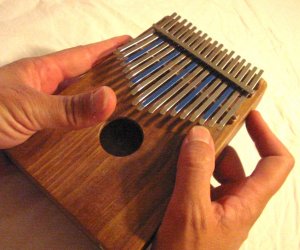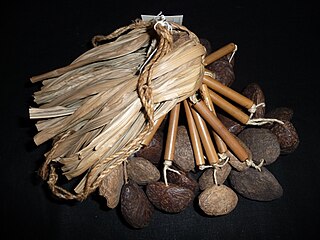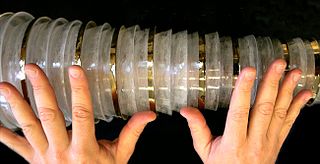
A percussion instrument is a musical instrument that is sounded by being struck or scraped by a beater including attached or enclosed beaters or rattles struck, scraped or rubbed by hand or struck against another similar instrument. Excluding zoomusicological instruments and the human voice, the percussion family is believed to include the oldest musical instruments. In spite of being a very common term to designate instruments, and to relate them to their players, the percussionists, percussion is not a systematic classificatory category of instruments, as described by the scientific field of organology. It is shown below that percussion instruments may belong to the organological classes of ideophone, membranophone, aerophone and cordophone.

In organology, the study of musical instruments, many methods of classifying instruments exist. Most methods are specific to a particular cultural group and were developed to serve that culture's musical needs. Culture-based classification methods sometimes break down when applied outside that culture. For example, a classification based on instrument use may fail when applied to another culture that uses the same instrument differently.
Hornbostel–Sachs or Sachs–Hornbostel is a system of musical instrument classification devised by Erich Moritz von Hornbostel and Curt Sachs, and first published in the Zeitschrift für Ethnologie in 1914. An English translation was published in the Galpin Society Journal in 1961. It is the most widely used system for classifying musical instruments by ethnomusicologists and organologists. The system was updated in 2011 as part of the work of the Musical Instrument Museums Online (MIMO) Project.

An idiophone is any musical instrument that creates sound primarily by the vibration of the instrument itself, without the use of air flow, strings (chordophones), membranes (membranophones) or electricity (electrophones). It is the first of the four main divisions in the original Hornbostel–Sachs system of musical instrument classification. The early classification of Victor-Charles Mahillon called this group of instruments autophones. The most common are struck idiophones, or concussion idiophones, which are made to vibrate by being struck, either directly with a stick or hand or indirectly, with scraping or shaking motions. Various types of bells fall into both categories. A common plucked idiophone is the Jew's harp.

The glass harmonica, also known as the glass armonica, glass harmonium, bowl organ, hydrocrystalophone, or simply the armonica or harmonica, is a type of musical instrument that uses a series of glass bowls or goblets graduated in size to produce musical tones by means of friction. It was invented in 1761 by Benjamin Franklin.

A lamellophone is a member of the family of musical instruments that makes its sound by a thin vibrating plate called a lamella or tongue, which is fixed at one end and has the other end free. When the musician depresses the free end of a plate with a finger or fingernail, and then allows the finger to slip off, the released plate vibrates. An instrument may have a single tongue or a series of multiple tongues.

A rattle is a type of percussion instrument which produces a sound when shaken. Rattles are described in the Hornbostel–Sachs system as Shaken Idiophones or Rattles (112.1).

A crystallophone is a musical instrument that produces sound from glass.

The nail violin is a musical instrument which was invented by German violinist Johann Wilde in 1740. The instrument consists of a semicircular wooden soundboard, approximately 1.5 feet (46 cm) by 1 foot (30 cm) in size, with iron or brass nails of different lengths arranged to produce a chromatic scale when bowed.
Struck idiophones is one of the categories of idiophones that are found in the Hornbostel-Sachs system of musical instrument classification.
A blown idiophone is one of the categories of musical instruments found in the Hornbostel-Sachs system of musical instrument classification. These idiophones produce sound when stimulated by moving air. For example, the aeolsklavier features sticks while the piano chanteur features plaques.

A musical instrument is a device created or adapted to make musical sounds. In principle, any object that produces sound can be considered a musical instrument—it is through purpose that the object becomes a musical instrument. A person who plays a musical instrument is known as an instrumentalist. The history of musical instruments dates to the beginnings of human culture. Early musical instruments may have been used for rituals, such as a horn to signal success on the hunt, or a drum in a religious ceremony. Cultures eventually developed composition and performance of melodies for entertainment. Musical instruments evolved in step with changing applications and technologies.

There are several overlapping schemes for the classification of percussion instruments.
This family of musical instruments includes those whose primary material is glass. They may be played using percussive techniques, such as striking the glass to produce a sound, or by utilizing friction to generate a resonant sound. Many glass instruments produce an ethereal, otherworldly timbre. A well-known glass instrument is Ben Franklin's glass harmonica.











